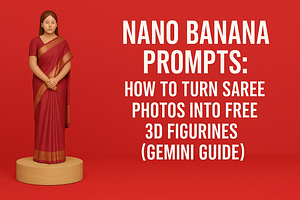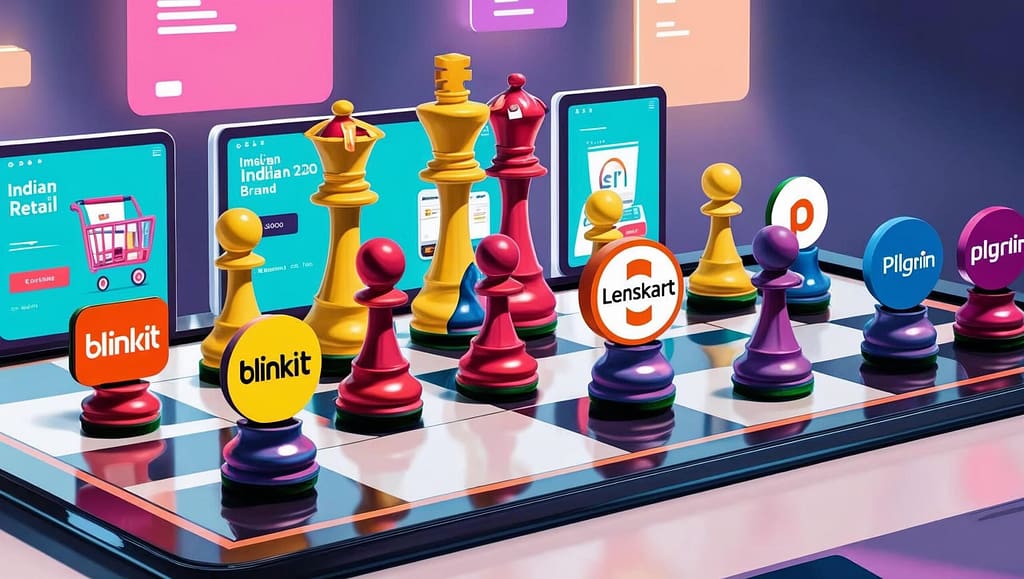Unpacking Recent Buzz and Updates – some exciting, some futuristic in Indian D2C & e-commerce
First, some context. We have launched our first ever weekly newsletter, which covers ten important business topics in one go at one place with context that matters to you most as a professional.
In The Brand new and our First Newsletter, we explore BlinkIt's D2C expansion, Pilgrim's impressive funding, Lenskart's IPO plans, WinZO's gaming empire, Zypp Electric's growth, D2C funding landscape, omnichannel strategies, FMCG D2C innovations, EcoSoul's sustainable success, and gaming industry projections.
Subscribe to stay updated on India’s most dynamic business newsletter.
Let's Start with some Exciting Brand Buzz Strategic Pivots & Milestone Moments
Pilgrim’s ₹200 Cr Fundraising Triumph 💄

First, some context. Founded in 2019 by Anurag Kedia and Gagandeep Makker, Pilgrim has quickly established itself as a formidable player in India’s beauty and personal care D2C landscape. The company offers over 90 SKUs including face care, haircare, skincare products, and fragrances, with a distinct focus on international beauty formulations tailored for Indian consumers.
The international innovation angle. What sets Pilgrim apart is its approach to sourcing ingredients from France, Korea, Spain, and Australia while customizing formulations specifically for Indian skin types and preferences. This global-local strategy has resonated strongly with consumers seeking international quality with market-specific application.
The funding milestone. In March 2025, Pilgrim secured a substantial ₹200 crore in a mix of primary and secondary transactions at a pre-money valuation of ₹3,000 crore (approximately $346 million). This brings their total funding to $56 million, with backing from investors like Fireside Ventures, Vertex Ventures, Mirabilis Investment Trust, and others.
The competitive landscape. Pilgrim competes directly with established D2C beauty brands like Mamaearth, The Ayurveda Experience, Bella Vita Organic, and Minimalist. However, its focus on international formulations adapted for Indian consumers creates a distinctive positioning in this crowded market.
Our take: Pilgrim’s successful adaptation of global beauty formulations for the Indian market demonstrates the power of “glocalization” in the D2C space. Their impressive valuation reflects investor confidence in their differentiated approach and potential to scale across both online and offline channels in a highly competitive beauty segment.
Lenskart’s Ambitious $1 Billion IPO Strategy 👓

First, some context. Lenskart, the eyewear unicorn, is preparing for a massive $1 billion IPO on Indian bourses by the end of FY26. The company has appointed Kotak Mahindra Bank and Morgan Stanley for the listing and is reportedly targeting a valuation of $10 billion. This would make it one of India’s most valuable consumer-focused tech IPOs.
The growth metrics. Lenskart has shown impressive financial performance, narrowing its net loss by 84% to ₹10 crore in FY24 from ₹64 crore in the previous year. Meanwhile, its operating revenue jumped 43% to ₹5,427.7 crore. The company plans to file its draft papers by May 2025.
The funding foundation. To date, Lenskart has raised nearly $1.8 billion across multiple funding rounds from marquee investors like Chiratae Ventures, TPG, Premji Invest, and Unilazer Ventures. This substantial capital base has enabled rapid expansion of both online operations and physical store networks.
The omnichannel mastery. What stands out about Lenskart’s strategy is its successful execution of the omnichannel approach, with over 1,000 stores across India while maintaining a strong digital presence. This hybrid model has given Lenskart a significant edge over pure-play online or offline competitors.
Our take: Lenskart’s potential $10 billion valuation demonstrates the market’s recognition of their omnichannel excellence. By effectively blending digital innovation with physical retail experience in the specialized eyewear category, they’ve created defensible moats that justify premium multiples despite the challenging IPO environment for consumer tech.
WinZO’s ₹1,055 Cr Gaming Revolution 🎮

Let’s set the stage. WinZO, the top social gaming platform in India, has had an incredible year, with revenue jumping by 70% to reach ₹1,055 crore and profits skyrocketing by 151% to ₹315 crore. The platform is home to over 10 crore users, with a whopping 90% hailing from Tier 2 to Tier 5 cities, and around 80% enjoying content in regional languages like Hindi, Tamil, Telugu, and Bengali.
Now, let’s talk about those micro-transactions. WinZO handles an astonishing 55 billion transactions each year, mainly through the small payments users make for game upgrades, skins, or extra lives. Thanks to its smooth integration with UPI, these micro-transactions are practically seamless for users.
And what about investor confidence? WinZO has successfully raised over $110 million so far, attracting investors like California’s Griffin Gaming Partners, Maker’s Fund, Courtside, and Kalaari Capital. In 2023, the company kicked off a $50 million ‘Game Developer Fund’ aimed at investing in global startups in the realms of interactive entertainment, game development, and content creation
Looking ahead, the market outlook is bright. WinZO’s India Gaming Market Report 2025 predicts that the Indian online gaming industry will grow from $3.7 billion in 2024 to $9.1 billion by 2029, boasting a CAGR of 19.6%. The report even suggests that the industry could hit an impressive $60 billion by 2034, potentially generating 2 million jobs.
In our view, WinZO’s remarkable performance underscores the untapped potential of non-metro India in the digital entertainment space. Their focus on localization, paired with a hassle-free micro-payment system, has crafted a scalable economic model that challenges traditional ideas about monetization in Tier 2+ markets. The ripple effect goes beyond gaming, paving the way for a new blueprint for the digital economy.
Zypp Electric’s ₹455 Cr B2B EV Success 🔋

Let’s set the stage. Zypp Electric has seen its revenue soar by 50% year-over-year, reaching ₹455 crore in FY 25, thanks to its rapid growth in major cities and the increasing demand from quick commerce companies. Operating on a driver rental model, Zypp is poised to be a frontrunner in the B2B EV revolution for last-mile delivery in India.
Here’s a fact: Zypp has surpassed 10 crore deliveries since it started, with quick commerce making up 47% of those. Recently, the company secured $6.5 million in its ongoing Series C funding round in January 2025, bringing its valuation to around $324 million.
Now, about their expansion plans. Zypp Electric is targeting the deployment of 2,000 dark stores by December 2025, which is a whole year ahead of their original timeline. To fuel this growth, Zomato has made a significant investment, with the current Series C round expected to raise between $35-$40 million.
The company aims to expand its reach to 30 cities across India by December 2025, up from its current operations in Delhi, Bengaluru, Mumbai, and Hyderabad.
And let’s talk about their move into 3-wheelers. While Zypp initially focused on 2-wheeler EVs, they’ve now branched out into the 3-wheeler market, which already contributes 10% to their revenue. They’re also eyeing Southeast Asia, with a pilot launch set for Indonesia and potential expansions into Thailand and the Philippines.
Our perspective: Zypp’s smart decision to incorporate 3-wheelers into their fleet shows a keen understanding of the evolving delivery landscape. By diversifying their vehicle lineup while keeping technological consistency across their platform, they’re not only boosting operational efficiency but also positioning themselves as a go-to partner for electrifying last-mile logistics across various vehicle types.
Zomato’s BlinkIt Transforms into D2C Powerhouse 🚀

First, some context. Zomato is expanding BlinkIt beyond quick commerce into a full-fledged D2C platform, putting it in direct competition with giants like Amazon and Flipkart. The company is building dedicated supply chain infrastructure to source branded products directly and manage inventory more efficiently, with a focus on increasing average order value (AOV).
Fact. In Q3 FY24, BlinkIt’s gross order value (GOV) surged 103% year-on-year to ₹3,542 crore, with ad revenue growing by an impressive 220%. Most recently, Zomato injected ₹1,500 crore into BlinkIt (February 2025), bringing the total investment to ₹4,300 crore since acquisition.
The dark store acceleration. BlinkIt has surpassed the 1,000-store mark with the addition of 216 new dark stores in a single quarter. The company is now eyeing 2,000 stores by December 2025, a full year ahead of its previous target.
This rapid expansion has temporarily impacted EBITDA margins, but the company views this as a strategic investment in market share. Analysts note that Blinkit's adjusted EBITDA loss of ₹103 crore in Q3 was up 13X from the previous quarter due to these upfront investments.
The Brand Stores moat. A key differentiator for BlinkIt is its recently launched Brand Stores platform, which allows D2C startups and FMCG brands to create custom brand pages on the app. Brands can highlight different products, engage directly with customers, and access real-time performance analytics.
This strategic move strengthens BlinkIt's position as a preferred platform for both established brands and emerging D2C players.
Our take: BlinkIt’s transformation from a quick-commerce player to a comprehensive D2C platform represents a significant strategic pivot that could redefine the competitive landscape. By leveraging its last-mile logistics strengths while building robust brand partnerships, BlinkIt is creating a differentiated value proposition that traditional e-commerce players will find difficult to replicate.
Quick Commerce Revolution: Blinkit’s Bold Green Leap and Digital Future
Funding Pulse in a Time of Turmoil
Indian D2C Funding Climate Cools in 2025 📉

Let’s set the stage. In 2024, India’s D2C sector saw a funding dip to $757 million, which is an 18% decrease from the $930 million raised in 2023 and a staggering 54% drop from the $1.6 billion in 2022.
This slowdown is a sign of investor caution, influenced by the global economic downturn, an oversaturated market with similar brands, and the unpredictable unit economics stemming from high customer acquisition costs.
Now, onto the profitability pressure. D2C brands are grappling with rising challenges, such as expensive offline expansion and the urgent need to pivot towards profitability. This has prompted many brands to rethink their growth strategies, shifting their focus from sheer growth metrics to building sustainable business models.
Looking at the market potential, even with the funding slowdown, industry forecasts are still optimistic about the long-term outlook for the sector. The D2C market in India, which was valued at $44.6 billion in 2021, is projected to hit $100 billion by 2025.
This indicates that quality brands with strong unit economics will continue to draw investment, even amidst the overall funding decline.
Then there’s the consolidation opportunity. As funding becomes more selective, the market is primed for consolidation. Established players with solid financials are in a great position to acquire smaller D2C brands that are struggling with funding, potentially leading to the rise of D2C conglomerates with a variety of brand portfolios.
Our perspective: This funding recalibration signals a positive shift from growth driven by valuations to a focus on sustainable business fundamentals. This transition is likely to speed up category consolidation and highlight operational excellence as a key differentiator.
Brands that can demonstrate a clear path to profitability with capital-efficient models will come out stronger, while those relying on constant funding will face serious challenges.
Latest Trends You Shouldn't miss as a professional & Entrepreneur
The Omnichannel Imperative for D2C Success 🏪

First, some context. Newer D2C brands in India, particularly in fashion, footwear, and food, are aggressively adopting a hybrid business model that combines online presence with physical retail. Unlike earlier D2C players who focused primarily on digital channels, brands like Snitch, Mokobara, and Pilgrim are prioritizing an omnichannel approach from early stages of growth.
The rapid offline expansion. These new-age D2C brands are opening brick-and-mortar outlets soon after securing initial funding, recognizing that physical stores provide crucial touchpoints for customer acquisition and brand building.
This strategy allows them to cater to a larger audience base and create multiple engagement opportunities.
The data-driven advantage. What sets these omnichannel D2C brands apart is their data-driven approach to expanding physical presence. By leveraging customer insights from their digital operations, they can strategically locate stores in high-potential areas, optimize inventory, and deliver personalized in-store experiences.
The government catalyst. Government initiatives such as Digital India, expanded internet connectivity, and support for local businesses have created a conducive environment for D2C brands to thrive across both online and offline channels.
As the e-commerce ecosystem matures, these brands are well-positioned to capture significant market share through their integrated approach.
Our take: The accelerated omnichannel adoption by emerging D2C brands reflects a maturing understanding of India’s complex retail landscape.
These brands recognize that digital-first doesn’t mean digital-only, especially in high-involvement categories where physical touchpoints significantly influence conversion rates and build consumer trust. This hybrid approach effectively combines digital efficiency with experiential retail.
FMCG Giants Embrace D2C Innovation 🛒

Let’s break it down: First off, traditional FMCG companies are really starting to embrace direct-to-consumer (D2C) models to enhance their usual distribution methods. Big names like Nestle, PepsiCo, and Coca-Cola are diving into D2C strategies in India, as they see more and more consumers wanting to connect directly with brands.
Now, let’s talk about the millennial opportunity. A big reason for this shift is the rising millennial population and their changing tastes, especially towards organic and plant-based products. This group tends to buy directly from brands they trust, which opens up a fantastic chance for FMCG companies to build direct relationships with their customers.
Who are millennials, you ask? They’re folks born roughly between 1981 and 1996, so they’re currently around 29 to 44 years old. This generation is a key consumer group because they wield significant purchasing power and often shop in ways that differ from older generations.
Now, onto the data advantage. By moving to D2C channels, FMCG giants can tap into valuable consumer data that used to be in the hands of retailers. This first-party data is a game changer, allowing for better product innovation, personalized marketing, and a more agile supply chain.
What’s first-party data, you might wonder? It’s the information a company gathers directly from its customers, like their purchase history, website interactions, and survey feedback. It’s way more valuable than third-party data since it comes straight from their own customer base.
Finally, let’s look at the market potential. The global Food & Beverage sector is a whopping $12 trillion+ market, and D2C channels are carving out an increasingly significant slice of that pie. In India alone, with over 190 million digital shoppers (the third-largest online shopping base in the world), the opportunity for FMCG D2C growth is huge, especially as digital payment systems keep improving.
Our take: Big FMCG companies are finally catching up to what smaller brands figured out years ago – building direct relationships with customers is crucial. By selling directly to consumers, these giants can better understand what people want and adapt faster in today’s rapidly changing market.
Quick Commerce India: The Retail Shakeup Shocking the Industry!
EcoSoul’s Sustainable Success Story ♻️

Let’s dive into the context. EcoSoul was born out of a desire to swap out traditional kitchenware for sustainable options. They offer compostable plates, cutlery, and cutting boards crafted from renewable materials like sugarcane, bamboo, and palm leaves.
Their commitment to both functionality and environmental responsibility has struck a chord with eco-conscious consumers.
So, what does compostable mean? It refers to products that can naturally decompose into non-toxic elements (think soil) when disposed of correctly. Unlike regular plastic, which can linger in landfills for centuries, compostable items return to nature in a much shorter time frame.
Now, let’s talk about their funding milestone. With a $10 million Series A funding round in 2023, EcoSoul has been able to ramp up its operations and broaden its product range. This significant investment showcases the increasing confidence investors have in sustainable consumer brands that offer clear value.
What makes EcoSoul stand out? It’s their keen focus on both style and practicality. Their products are built to withstand daily use while being kind to the planet. This blend of usability and sustainability has helped them cultivate a loyal following.
What is product differentiation, you ask? It’s all about making your products stand out from the competition in ways that matter to customers. EcoSoul achieves this by creating eco-friendly items that are not only practical but also visually appealing—not just good for the environment, but good for everyday life.
Looking at market expansion, EcoSoul’s mission aligns seamlessly with a growing number of consumers eager to adopt greener lifestyles without complicating their daily routines. The company has shown that eco-friendly choices can be both practical and budget-friendly, tapping into a broader market beyond just the environmentally aware early adopters.
Our take? EcoSoul shines by making sustainability straightforward. By offering eco-friendly products that perform just as well as traditional options without a hefty price tag, they’re making it easier for everyday folks to make greener choices.
Passionate About Sustainability and Eco Friendly environment , you can't miss this blog:
Build a Sustainable D2C Brand: Avoid Greenwashing
Indian Gaming Industry’s $60 Billion Trajectory 🎯

First, some context. The Indian gaming industry is experiencing explosive growth, with the online market projected to expand from $3.7 billion in 2024 to $9.1 billion by 2029, growing at a CAGR of 19.6%. Looking further ahead, the sector is expected to reach a market size of $60 billion by 2034, with the potential to create 2 million jobs.
The user dominance. India currently houses 591 million gamers, representing nearly 20% of the global gaming user base. This massive player population presents an unprecedented opportunity for game developers, publishers, and gaming-adjacent services.
What are gaming-adjacent services? Gaming-adjacent services are businesses that support the gaming industry but aren’t game developers themselves. These include companies that handle payments for games, create gaming hardware, organize e-sports tournaments, or provide streaming platforms for gamers.
The investment potential. The industry is poised to unlock $26 billion in investor value, with India’s sole publicly listed gaming company, Nazara, setting a premium valuation benchmark.
This suggests significant untapped potential for investors looking to enter the Indian gaming market.
What is a valuation benchmark? A valuation benchmark is like a measuring stick used to figure out how much companies in the same industry might be worth. Nazara’s high valuation helps investors estimate the potential value of other gaming companies.
The future catalysts. The export of ‘Made in India’ gaming IPs and the global expansion of Indian gaming companies are expected to play crucial roles in solidifying India’s position as a global gaming powerhouse. Government initiatives supporting the creator economy, including a recently announced $1 billion fund, are further accelerating growth in the sector.
What is IP in gaming? IP stands for “Intellectual Property.” In gaming, this means the original game characters, stories, worlds, and concepts that companies create and own. Popular gaming IPs can be used to make multiple games, movies, merchandise, and more.
Our take: India’s gaming surge isn’t just about entertainment – it’s creating millions of jobs and building a whole new industry. With government support, a massive young population comfortable with technology, and growing investment, India is transforming from just a game consumer to a major producer.
Have an Idea to Build a Sustainable Brand its as easy as getting 10 Minutes delivery from your favourite Quick Commerce, Just Click the Link Below and Follow Step by Step Process and Launch your Brand in Half an Hour
AI Powered D2C Business Toolkit: Click & Play
Let’s Build Something Great Together
Have an idea, a question, or just want to explore how we can help your brand grow? Contact Us
Follow @D2C Today Linkedin Page for real-time updates on India’s most exciting direct-to-consumer brands, founder journeys, funding trends, product breakdowns, and more.
Whether you're building, investing, or just curious—this is your backstage pass to the future of commerce.







